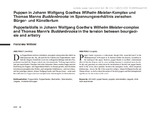Citation link:
http://dx.doi.org/10.25819/dedo/105Files in This Item:
| File | Description | Size | Format | |
|---|---|---|---|---|
| Willbold_Goethe_Mann_Dedo4.pdf | 1.01 MB | Adobe PDF |  View/Open |
| Dokument Type: | Article | metadata.dc.title: | Puppen in Johann Wolfgang Goethes »Wilhelm Meister«-Komplex und Thomas Manns »Buddenbrooks« im Spannungsverhältnis zwischen Bürger- und Künstlertum | Other Titles: | Puppets/dolls in Johann Wolfgang Goethe's »Wilhelm Meister«-complex and Thomas Mann's »Buddenbrooks« in the tension between bourgeoisie and artistry | Authors: | Willbold, Franziska | Free keywords: | Puppenmotiv, Puppentheater, Marionetten, Determination, Diegese, Kindheitserfahrungen, Doll motif, Puppet theatre, Puppets, Determination, Diegesis, Childhood experiences | Issue Date: | 2021 | Publish Date: | 2021 | Publisher: | universi - Universitätsverlag Siegen | Journal: | denkste: puppe / just a bit of: doll (de:do) | Source: | denkste: puppe - multidisziplinäre zeitschrift für mensch-puppen-diskurse; Bd. 4 Nr. 1 (2021): Puppen als Seelenverwandte – biographische Spuren von Puppen in Kunst, Literatur, Werk und Darstellung. - ISSN: 2568-9363 ; 42-51 | Abstract: | Das Puppentheater stellt ein verbreitetes, wenngleich wenig erforschtes Motiv im Bildungsroman dar. Das gilt auch für die Funktion des Puppentheaters innerhalb der Diegese. Gemäß der Lesart des vorliegenden Beitrags wird dem Puppentheater innerhalb der Diegese jedoch eine determinierende Wirkung zugeschrieben und sein sinnstiftender Charakter wird näher beleuchtet. Hierzu werden Fragen nach der Einführung des Puppen- und Puppentheater-Motivs im Roman gestellt, nach Parallelen zwischen den exemplarischen Werken, nach reziproken Verhältnissen – auch zur Lebenswelt der jeweiligen Autoren, Johann Wolfgang Goethe und Thomas Mann – sowie nach Beschaffenheit der Puppen und deren metaphorischer Bedeutung für den Romankontext. Puppet theater represents a widespread, though little researched motif in the ‘Bildungsroman’ with regard to its function within the diegesis. According to the reading of this paper, however, puppet theater is ascribed a determinant effect within the diegesis, and its sense-making character is examined more closely. To this end, questions are asked about the introduction of the doll and puppet theater motif in the novel, about parallels between the exemplary works, about reciprocal relationships - also to the life of the respective authors, Johann Wolfgang Goethe and Thomas Mann - as well as about the nature of the dolls/puppets and their metaphorical significance for the context of the novel. |
DOI: | http://dx.doi.org/10.25819/dedo/105 | URN: | urn:nbn:de:hbz:467-20846 | URI: | https://dedo.ub.uni-siegen.de/index.php/de_do/article/view/105 https://dspace.ub.uni-siegen.de/handle/ubsi/2084 |
License: | http://creativecommons.org/licenses/by-sa/4.0/ |
| Appears in Collections: | universi - Zeitschriftenartikel |
This item is protected by original copyright |
Page view(s)
243
checked on Nov 30, 2024
Download(s)
305
checked on Nov 30, 2024
Google ScholarTM
Check
Altmetric
This item is licensed under a Creative Commons License


